A New Look
We are introducing a new look to NativeScape this month, with higher image resolution and more up-to-date design elements. Feel free to share your comments: nativescape@gnps.org
Chapter News: Redbud
Sarah Krouse and Margaret Rasmussen
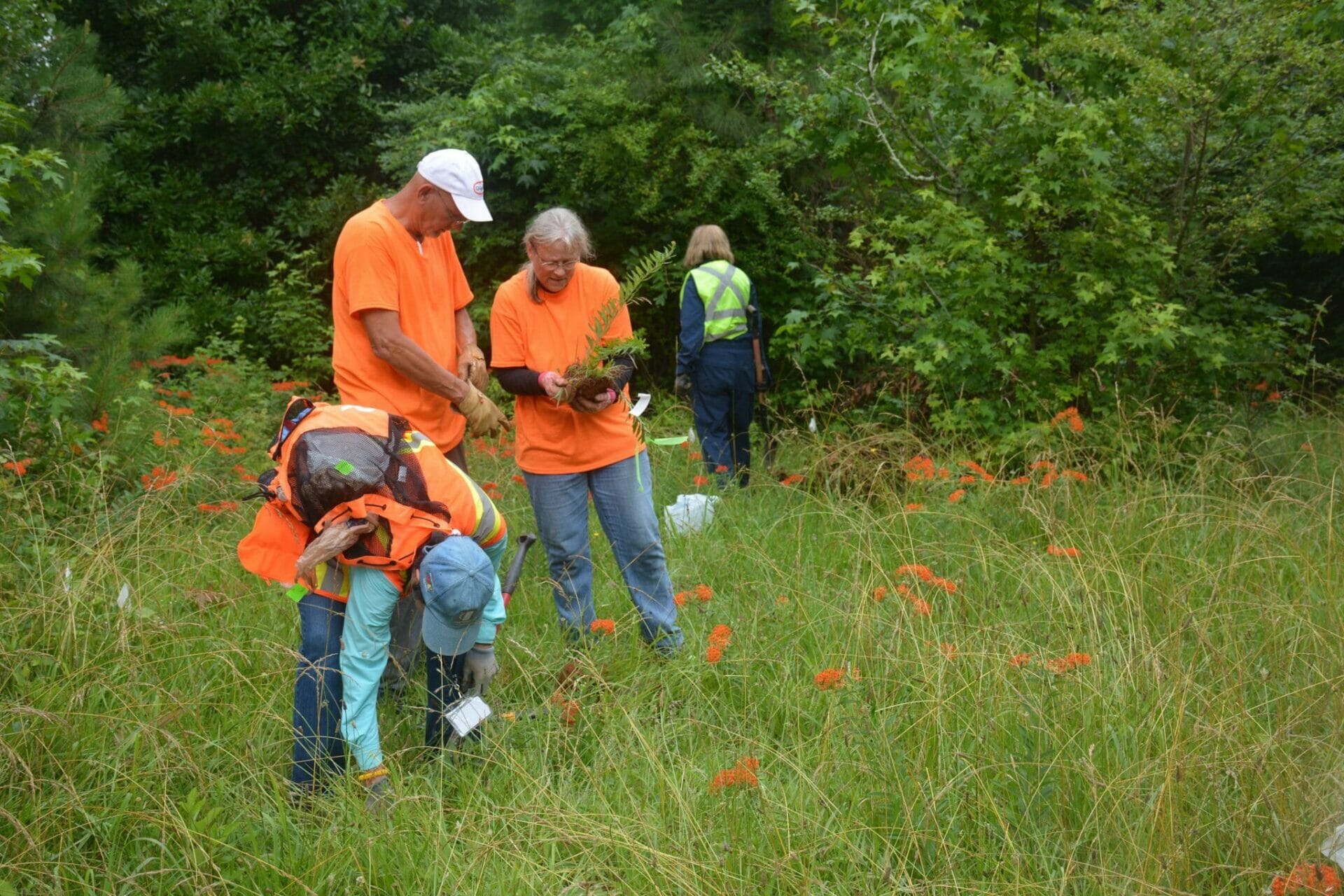
Teaching new rescuers is part of Redbud's commitment to conservation.
In a field of butterfly weed, participants in Redbud's “Native Plant Identification Series” were delighted as they took part in a plant rescue this past June. The mission was to teach proper methods and criteria for a successful rescue. Held on a 30-acre site slated for development in south Hall County, this training was a segment of Redbud’s four-part series on conserving native plants of the Gainesville Ridges and was conducted by the four facilitators of the Redbud Chapter.
Also in June, Mr. Nathan Wilson, Horticulturist and Manager of Lanier Nursery and Gardens in Gainesville, spoke on the topic of IPM (integrated pest management) as a way of deterring deer in suburban and urban gardens. Loss of habitat due to economic development is increasing, and deer have become the largest garden pest in the Southeast. Nathan discussed how to properly combine IPM as a way to effectively minimize their damage to the landscape.
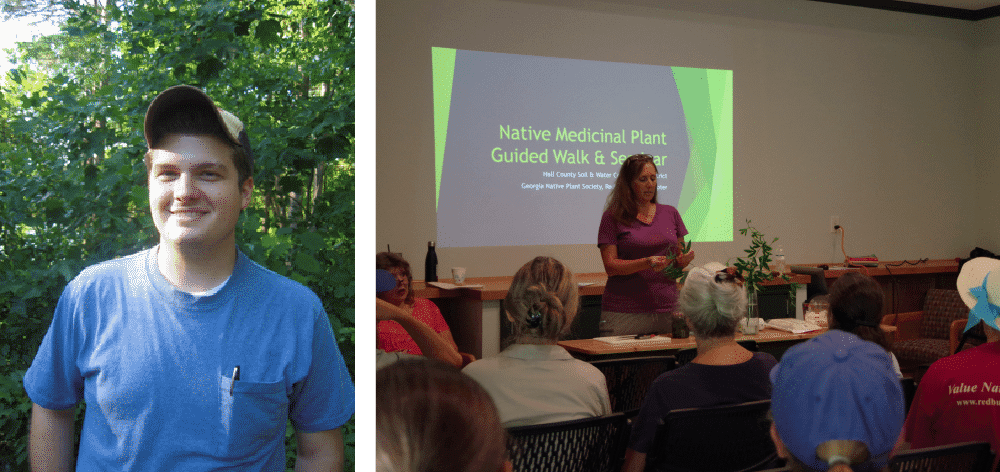
Nathan Wilson (left) and Karen Hicks (right) have been recent speakers at Redbud events.
In July, the Redbud Chapter held a Medical Botany seminar at the Linwood Nature Preserve. The seminar focused on indigenous native plants of the Northeast Georgia region that have been used medicinally from the early days of the Native Americans and Colonists. Participants enjoyed a demonstration on making a passiflora tincture while snacking on lemon balm cookies and sassafras tea. Speakers included Irenee Payne, agent of the Hall County Soil & Water Conservation District, Margaret Rasmussen, executive director of the Redbud Chapter, Pam Eakins, certified herbalist, and Karen Hicks, ecologist.
Plant Spotlight: Franklinia alatamaha
Tom Collins

This carpenter bee has found a Franklinia tree that was purchased at a GNPS Plant Sale about five years ago.
We often focus on widespread plants that are easy to cultivate, but not this time. Within decades after its discovery by John Bartram in 1765, Franklin tree (Franklinia alatamaha) was extinct in its very small native range along the Altamaha River in southeastern Georgia, and it still carries that designation of being extinct in the wild. The reasons for its disappearance in the wild have never been completely agreed upon, but one theory attributes it to the introduction of a cotton pathogen with the advent of the plantation economy. It certainly suffered from a limited genetic diversity in such a small range, and today's plants are all descendants of seeds collected by Bartram. Another theory is that Franklinia came south with the ice age, became geographically isolated, and never made it back home, which is consistent with its cold hardiness.
Although rare, it has been successively grown as far north as Boston, and the national champion is in Philadelphia, attaining a height of over 30 feet and a circumference of over 2 feet. The Georgia state champion is in the Quarry Garden at the Atlanta History Center. If you want to catch it in bloom, you have time – Franklin trees are blooming now, but can bloom up to the first frost. If you want to learn more, one good source is an article at www.terrain.org. If you're thinking about cultivating one, that source notes Franklinia “is sensitive to root rot and ... it is not a particularly vigorous plant. It requires enriched, well-drained, acidic soil with ample watering during dry periods. It is at best moderately drought- and heat-tolerant, yet amazingly it tolerates cold and subzero temperatures fairly well.”
Restoration Focus: The Cherokee Garden at Green Meadows Preserve
Carra and Tony Harris
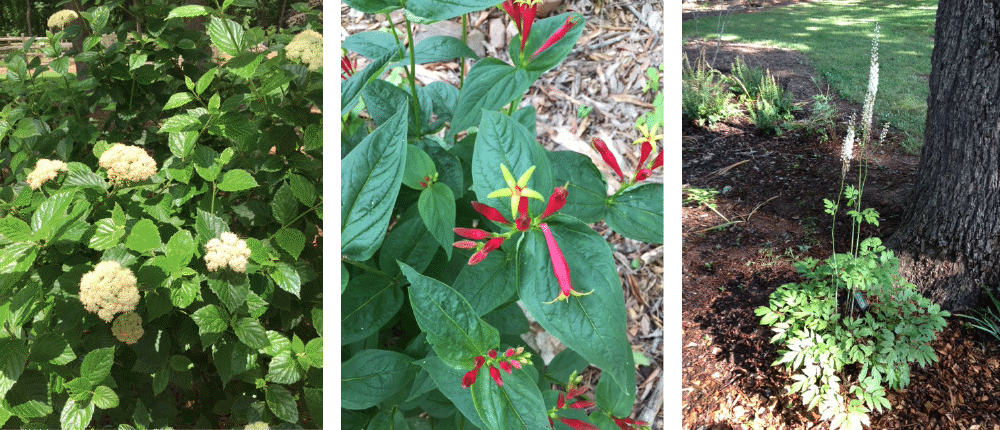
Blooming beauties at Cherokee Garden include arrowwood viburnum (Viburnum dentatum), Indian pink (Spigelia marilandica), and black cohosh (Actaea racemosa).
It was a wonderful spring in the Cherokee Garden! We had ample rainfall and a prolonged cold winter that many of the perennials loved. The garden was able to acquire about twenty perennials and shrubs from the Stone Mountain Propagation Project, and they are adapting quite well. We are finally seeing many of the plants reseeding or spreading, and that is a wonderful problem to have in any garden.
The North Cobb Rotary Club donated a large pallet of fieldstone, enabling our Thursday morning volunteers to line additional pathways through the new Arboretum Section. We are in the process of applying for grant funds to purchase additional native trees and slate chips for the pathways.
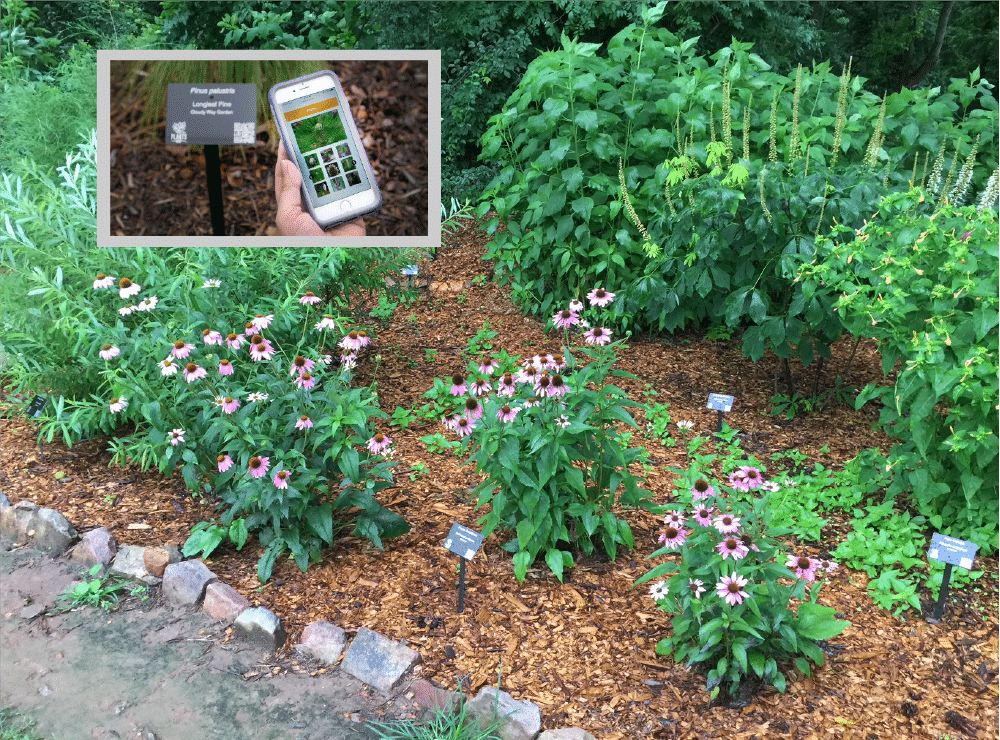
Visitors to Cherokee Garden find clearly labeled plants and helpful QR codes that direct them to more information.
After four years it is exciting to see the Cherokee Garden mature into a real “garden”. Although there has been little media coverage, the Cherokee Garden is developing a larger presence in the Atlanta community. This spring, we have hosted two DAR chapters, garden clubs from Cartersville and Rome, and two homeschooling co-ops. On June 25th, we were honored to host 25 members from the Atlanta Botanical Garden’s volunteer docents. It was heartwarming to hear their positive comments.
The Cherokee Garden in located in West Cobb and is open to the public seven days a week. Each native plant is clearly labeled and more plant information is available by activating your cell phone’s QR Reader. Our location is Cobb County’s Green Meadows Preserve Park, 3780 Dallas Highway, Marietta, Georgia.
Georgia Tech Field Trip
Tom Collins
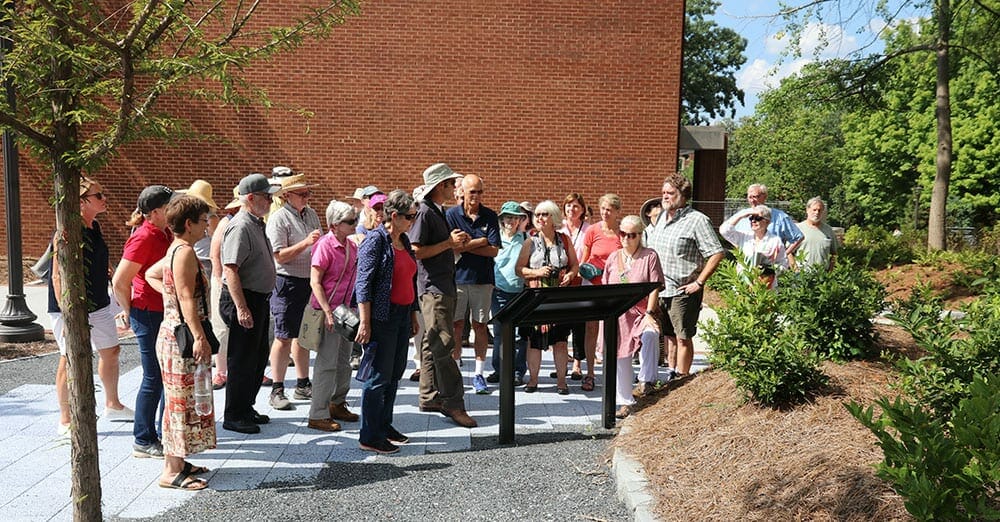
Jason Gregory (center, gesturing with hands) explains a hardscape feature, the model of the Seven Bridges of Königsberg.
On July 25th, about thirty GNPS members got an inside look at plants and the water than sustains them on the Georgia Tech campus. Historically, Tanyard Creek ran roughly from south to north through the center of campus, and today it emerges from a combined sewer overflow north of Atlantic Station and through a park on the Beltline. All of the stormwater in that drainage basin still flows under campus. Jason Gregory, landscape architect and educational facilities planner with Capital Planning and Space Management at Georgia Tech, provided an in-depth presentation about ongoing sustainabity efforts, including the first Living Building Challenge 3.0 certified education and research facility in the Southeast.
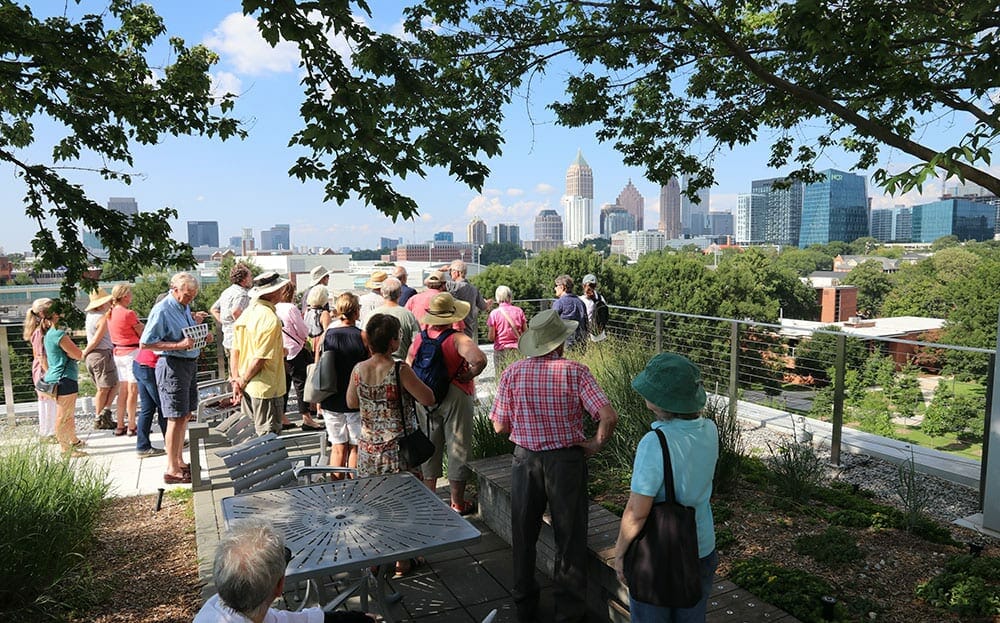
On the fifth story of the Clough Undergraduate Learning Commons, a rooftop garden provides a view of campus and beyond.
Jason then led the group on a walking tour that included the Clough rooftop garden overlooking a field with underground cisterns and pedestrian walkways with thousands of native shrubs and other plants. Near the north side of campus, the tour continued to a rock-lined storm drainage culvert lined with Joe Pye weed and other plants (see last month's NativeScape) and concluded in a rain garden complete with sculpture and terraced waterfalls.
Do you have any ideas for a field trip? Can you possibly lead one yourself? Field trips are a wonderful benefit of GNPS membership. Trips can be anywhere in Georgia, or maybe even outside the state, and we are ready to provide assistance in advertising it and setting up registration. Let us know at info@gnps.org.
Call for volunteers
Lane Conville-Canney
The Georgia Native Plant Society is seeking volunteers who love organizing, meeting new people, and talking to others about native plants.You do not need to be an expert – just willing to learn more! We would really like to have more volunteers from our chapters who are email-friendly to spread the word about GNPS through committee roles, which on average will only take a few hours each week. See the details below.
In addition, we are seeking to fill four Board positions that will take more time, on average about ten hours each week. The positions include Secretary, to take Board meeting minutes and prepare agendas, Director of Membership, to lead the move to recruit more members to GNPS and engage our current members with fun and educational events, Director of Conservation, to oversee our conservation committees, and Vice President, to assist the President in strategic priorities for GNPS. If you have an interest in a board position, please feel free to contact us at info@gnps.org.
Below are the other volunteer positions that have less of a time commitment than being a board member. Click on the links provided for more information, and email us at info@gnps.org for further discussion. We would love to have you join us.
- Events – we need people to recruit others to represent GNPS at festivals and farmers markets, details here
- Field trips – we need people to organize fun field trips like hikes and plant identification sites, details here
- Finance – we need people, some with a finance background, to join our finance committee, details here
- Meeting Programs – we need people to find six interesting speakers to present to our annual educational presentation series at the Atlanta Botanical Gardens, details here
- Membership – we need people to work with the Director of Membership to brainstorm and implement engaging ways of bringing new members to GNPS and keeping current members engaged in our work, which includes working with our member database, details here
- Merchandise – we need people to help sell merchandise at our events and set-up our online store, details here
- Newsletter – we need people to help gather content for our monthly newsletter, details here
- Restoration – we need people to support restoration sites to help recruit and connect interested volunteers for workdays, details here
- Symposium – we are looking for a co-chair for this great event who can take over in 2020, details here
Plant Sale Update
Martha Morris
Our annual GNPS Fall Plant Sale is September 22nd, only about 7 weeks away. The Plant Sale committee has spent countless hours brainstorming ideas, buying extra plants, and publicizing the event, as well as lining up several educational booths covering invasive plants, pollinators, professional landscaping advice, habitat certification, and more. We are very excited about the new additions to the fall plant sale. You will definitely want to come and this year and check it out.
We are still in need of volunteers to work the setup day (Friday, September 21st) and the sale day (Saturday, September 22nd). This is your opportunity as members to help GNPS have a successful Fall Plant Sale. Lunch will be provided, and volunteers will get first pick of plants to purchase. Simply visit the volunteer registration page to sign up. We hope that we can count on you. See you there!
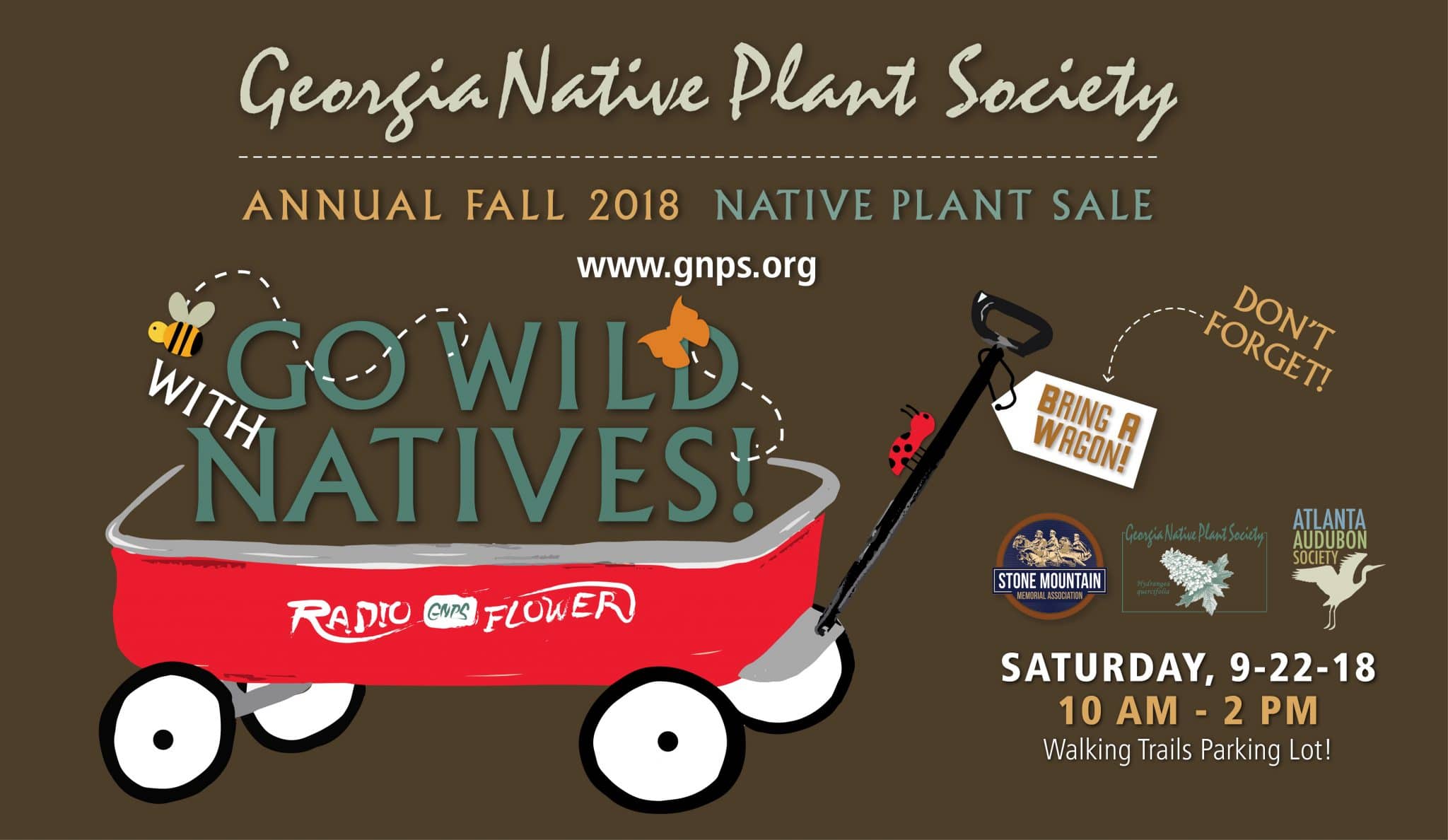
|